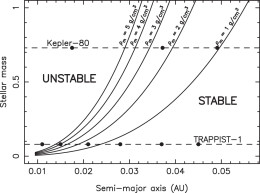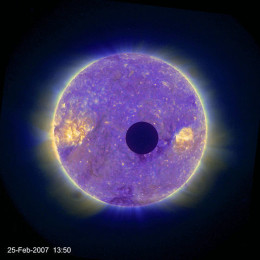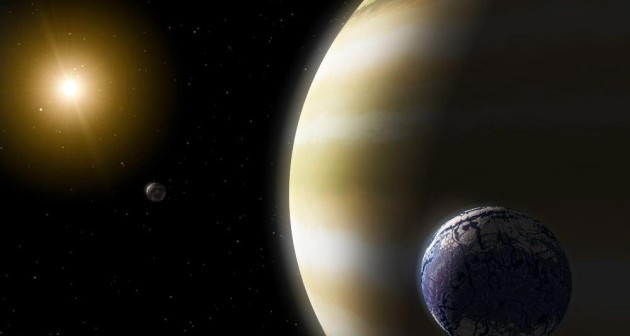Many of the exoplanets that we’ve discovered lie in compact systems with orbits very close to their host star. These systems are especially interesting in the case of cool stars where planets lie in the star’s habitable zone — as is the case, for instance, for the headline-making TRAPPIST-1 system.
But other factors go into determining potential habitability of a planet beyond the rough location where water can remain liquid. One possible consideration: whether the planets have moons.
Supporting Habitability

Locations of equality between the Hill and Roche radius for five different potential moon densities. The phase space allows for planets of different semi-major axes and stellar host masses. Two example systems are shown, Kepler-80 and TRAPPIST-1, with dots representing the planets within them. [Kane 2017]
A planet can retain a moon in a stable orbit anywhere between an outer boundary of the Hill radius (beyond which the planet’s gravity is too weak to retain the moon) and an inner boundary of the Roche radius (inside which the moon would be torn apart by tidal forces). The locations of these boundaries depend on both the planet’s and moon’s properties, and they can be modified by additional perturbative forces from the host star and other planets in the system.
In a new study, San Francisco State University scientist Stephen R. Kane modeled these boundaries for planets specifically in compact systems, to determine whether such planets can host moons to boost their likelihood of habitability.

Allowed moon density as a function of semimajor axis for the TRAPPIST-1 system, for two different scenarios with different levels of perturbations. The vertical dotted lines show the locations of the six innermost TRAPPIST-1 planets. [Kane 2017]
Challenge of Moons in Compact Systems
Kane found that compact systems have a harder time supporting stable moons; the range of radii at which their moons can orbit is greatly reduced relative to spread-out systems like our own. As an example, Kane calculates that if the Earth were in a compact planetary system with a semimajor axis of 0.05 AU, its Hill radius would shrink from being 78.5 times to just 4.5 times its Roche radius — greatly narrowing the region in which our Moon would be able to reside.
Kane applied his models to the TRAPPIST-1 system as an example, demonstrating that it’s very unlikely that many — if any — of the system’s seven planets would be able to retain a stable moon unless that moon were unreasonably dense.
Is TRAPPIST-1 Really Moonless?

Image of the Moon as it transits across the face of the Sun, as viewed from the Stereo-B spacecraft (which is in an Earth-trailing orbit). [NASA]
On the other hand, smaller moons (perhaps no more than 200–300 km in radius) would have escaped detection. Future long-term monitoring of TRAPPIST-1 with observatories like the James Webb Space Telescope or 30-meter-class ground-based telescopes will help constrain this possibility, however.
Citation
Stephen R. Kane 2017 ApJL 839 L19. doi:10.3847/2041-8213/aa6bf2

1 Comment
Pingback: moonless worlds and habitability